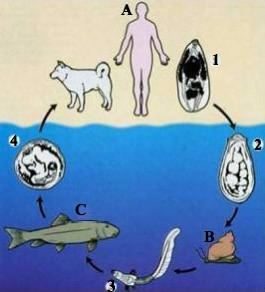Superfamily Opisthorchioidea Subfamily Metorchiinae Phylum Platyhelminthes | Genus Metorchis Rank Species | |
 | ||
Similar Opisthorchiidae, Digenea, Metagonimus yokogawai, Opisthorchis, Heterophyes heterophyes | ||
Metorchis conjunctus, common name Canadian liver fluke, is a species of trematode parasite in the family Opisthorchiidae. It can infect mammals that eat raw fish in North America. The first intermediate host is a freshwater snail and the second, a freshwater fish.
Contents
Taxonomy
This species was discovered and described by Thomas Spencer Cobbold in 1860.
Distribution
The distribution of Metorchis conjunctus includes:
Description
The body of Metorchis conjunctus is pear-shaped and flat. The body length is 1⁄4–3⁄8 inch (6.4–9.5 mm). There is a weakly muscular terminal oral sucker. There is no prepharynx. The pharynx is strongly muscular. The esophagus is very short. The intestinal ceca vary from almost straight to sinuous. The acetabulum is slightly oval and weakly muscular. There is an anterior testis and a posterior testis. The testes vary from almost round to oval, and may be deeply lobed or slightly indented. There is no cirrus pouch. The seminal vesicle is slender. The ovary is trilobed. The receptaculum seminis is elongated or pyriform, and slightly twisted, and situated to the right and behind the ovary.
The eggs are oval and yellowish brown.
Life cycle
The first intermediate host of Metorchis conjunctus is a freshwater snail, Amnicola limosus.
The second intermediate host is a freshwater fish: Catostomus catostomus, Salvelinus fontinalis, Perca flavescens, or Catostomus commersoni. Metacercaria of M. conjunctus were also found in northern pike (Esox lucius).
The definitive hosts are fish-eating mammals such as domestic dogs (Canis lupus familiars), domestic cats (Felis catus), wolves (Canis lupus), red foxes (Vulpes vulpes), gray foxes (Urocyon cinereoargenteus), coyotes (Canis latrans), raccoons (Procyon lotor), muskrats (Ondatra zibethicus), American minks (Neovison vision), fishers (Martes pennanti), or bears. It can also infect humans. It lives in the bile duct and in the gallbladder.
Effects on human health
Metorchis conjunctus causes a disease called metorchiasis. It has been known to infect humans since 1946. Humans had eggs of M. conjunctus in their stools, but they were asymptomatic (they had no symptoms of the disease). Sashimi from raw Catostomus commersoni was identified as a source for an outbreak in Montreal in 1993. It was the first symptomatic disease in humans caused by M. conjunctus.
Symptoms
After ingestion of fish infected with Metorchis conjunctus, it takes about 1–15 days for symptoms to occur, namely for eggs to be detected in the stool (incubation period).
The acute phase consists of upper abdominal pain and low-grade fever. There are high concentrations of eosinophil granulocytes in blood. There are also higher concentrations of liver enzymes. When untreated, symptoms may last from three days to four weeks. Symptoms of chronic infection were not reported.
Diagnosis and treatment
Eggs of Metorchis conjunctus can be found by stool analysis. Serologic analysis can be also used: ELISA test for IgG antibodies against antigens of M. conjunctus.
Drugs used to treat infestation include praziquantel: 75 mg/kg in 3 doses per day (the same dosage applies for adults and for children).
Effects on animal health
Watson and Croll (1981) studied symptoms of cats. Prevention include feeding with cooked fish (not raw fish).
Metorchis conjunctus was found to be a common infection of domestic dogs in Indian settlements in 1973.
The prevalence of M. conjunctus in wolves in Canada is 1–3%. In wolves, M. conjunctus causes cholangiohepatitis with periductular fibrosis in the liver. It sometimes causes chronic inflammation and fibrosis of the pancreas in wolves.
